By Gary Swick, President
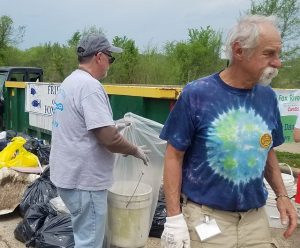
At our Yorkville river cleanup, I realized that my very full bag of trash was exceptionally light. It lacked the usual heavy glass bottles and pieces of metal. The contents were primarily cigarette butts, plastic bottles, food wrappers, and miscellaneous other plastic products like polystyrene (Styrofoam). These items end up as litter because they are durable materials, and their intended use for a consumer can be measured in minutes.
Barry Commoner is well known for his four ‘laws of ecology,’ which he outlined in the first chapter of his book, “The Closing Circle. Nature, Man and Technology”
Law #1: Everything is connected to everything else.
Consider that 1 million plastic water bottles are purchased every minute. Only 23% of those are disposed of through recycling. A bottle on the ground is bound for a river system, usually through a storm drain, or as riverside litter. Ten rivers (mostly in Asia) deliver 90% of all ocean pollution. Plastics do not decompose. When plastics break apart, they persist and are presented in edible and breathable sizes, often mistaken as food by marine life. One million seabirds and 100,000 marine animals die each year from ingesting plastics, with 700 species currently facing extinction due to plastic pollution.
Law #2: Everything must go somewhere.
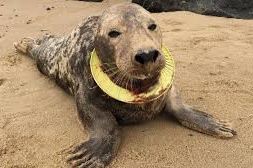 We have created a monster that will not go away. I, like many others, was horrified by a picture of a seal with a six-pack ring lodged around its neck, so I began the practice of cutting up those rings before disposing of them. I celebrated when a local company, Illinois Tool Works, manufactured break-away rings and unveiled photo degradable plastics. These advancements were, however, not a solution to the growing plastic problem. Now more than ever the heterogeneous waste stream prohibits plastic recycling and incineration (plastics have to be homogeneous for efficient recycling and incineration). Many forms of plastic that were once recyclable are not anymore. Plastic cups are an example. A product can be advertised as ‘compostable or degradable,’ but buried in a landfill, that just can’t happen due to lack of water and air.
We have created a monster that will not go away. I, like many others, was horrified by a picture of a seal with a six-pack ring lodged around its neck, so I began the practice of cutting up those rings before disposing of them. I celebrated when a local company, Illinois Tool Works, manufactured break-away rings and unveiled photo degradable plastics. These advancements were, however, not a solution to the growing plastic problem. Now more than ever the heterogeneous waste stream prohibits plastic recycling and incineration (plastics have to be homogeneous for efficient recycling and incineration). Many forms of plastic that were once recyclable are not anymore. Plastic cups are an example. A product can be advertised as ‘compostable or degradable,’ but buried in a landfill, that just can’t happen due to lack of water and air.
The Mother of Invention
Our inspiration for plastics is from Mother Nature’s milky latex from rubber trees. During World War II, much research and development went into plastic technology. Oil, plastic’s material source, was cheap, and lighter materials were in demand. Following the war, plastics found new uses. Nylon parachutes in the sky changed to hose on the thigh (nylon stockings). Cargo protection became food protection. From easily molded and cheap to produce plastics, we got Tupperware, plastic wrap, and straws that can, and do, last nearly forever.
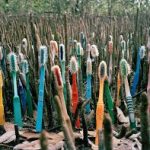 Developed in the 1940’s, the plastic toothbrush has seen little design change in 70 years. The American Dental Association recommends a new brush every 3 to 4 months. In the U.S. alone this amounts to 1 billion tooth brushes a year. Abandoning the cultural value of ‘use it up, wear it out,’ we have embraced the cheap convenience of the disposable concept from pens, lighters, diapers and more. By the 1960’s, U.S. plastic production passed steel production, and increased 400% in a decade. The rest of the world obediently followed.
Developed in the 1940’s, the plastic toothbrush has seen little design change in 70 years. The American Dental Association recommends a new brush every 3 to 4 months. In the U.S. alone this amounts to 1 billion tooth brushes a year. Abandoning the cultural value of ‘use it up, wear it out,’ we have embraced the cheap convenience of the disposable concept from pens, lighters, diapers and more. By the 1960’s, U.S. plastic production passed steel production, and increased 400% in a decade. The rest of the world obediently followed.
Realize that 2 million plastic bags are used every minute, and the average use is just for 12 minutes. Only 1% of plastic bags are returned for recycling. In 2007, San Francisco banned the use of retail plastic bags. Kenya, China, France, Rwanda, and Italy have also taken action to discourage their use. Yet, the U.S. and Japan refuse to sign the G7 Pact to address plastic pollution. Some states like Michigan have passed legislation banning any local bans on plastic bags. This is like climate change; a reality that can no longer be denied. We know the source and the impacts of the problem but seem to lack the leadership and the will to address it.
On a positive side, 5 states recently passed legislation to ban or limit intentional releases of balloons, and 8 other states are currently considering this. Please advocate for this with your family, friends, and representatives.
Law #3: Nature knows best.
The solution lies in awareness, will, and design. I use a textbook; “Cradle to Cradle”, that is made of plastic not paper. Yes, paper is a 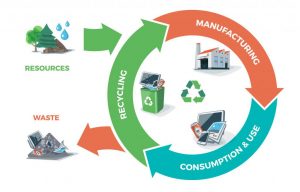 renewable resource. It is both recyclable and biologically degradable, but that biological nutrient (paper, like carbon) is not used in a cyclic pattern as in nature. It has a cradle to grave lifecycle. By design, this plastic book is an example of a technological nutrient, manufactured by into a common form that is designed to be easily upcycled into another product. The European Union has a Circular Economy Action Plan utilizing this philosophy. The goal for plastic is 75% recovery by 2030. We can do this here, but it takes conscious and collective action.
renewable resource. It is both recyclable and biologically degradable, but that biological nutrient (paper, like carbon) is not used in a cyclic pattern as in nature. It has a cradle to grave lifecycle. By design, this plastic book is an example of a technological nutrient, manufactured by into a common form that is designed to be easily upcycled into another product. The European Union has a Circular Economy Action Plan utilizing this philosophy. The goal for plastic is 75% recovery by 2030. We can do this here, but it takes conscious and collective action.
Law #4, There is no free lunch.
Plastics are not free. We ordered the lunch and it came with disposal problems, and health impacts to humans and Mother Nature, as unintended consequences. We have been duped by plastics. I used to proudly wear a shirt that said, “Kane County Recycles – this shirt made from 100% plastic bottles.” In my ignorance, I thought that this was a solution to the growing use of polyethylene terephthalate (PET #1) bottles. Plastics are light, durable, cheap, and versatile. But our heavy use has resulted in a holistically very expensive price tag. Nearly every human, and polar bear, has micro plastics in their blood stream.
We all play a role in this plastic mess. We can do our individual part with reusable shopping bags, saying “No” to single use plastics like straws and water bottles, and bringing our reusable carry-out containers to restaurants to avoid the burden of non-recyclable polystyrene containers. Pack your own washable utensils, cup, and straw for when you find yourself with only disposable options. Please do your part with the 3 Rs (recycle, reuse, reduce), and share your concern with others, at least by example. Advocate for responsible plastic use. Say goodbye to glitter, balloon releases, and any single-use plastic items.
Get More Connected
Join us in our “It’s Our Fox River Day – A Watershed-wide Celebration” on Saturday, Sept. 21st, or at one of our “Love Our River Day” cleanups in the Spring, because litter prevention and collection do make a difference. Remember the four laws of ecology:
1. Everything is connected to everything else.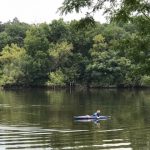

2. Everything must go somewhere.
3. Nature knows best.
4. There is no free lunch.
That is how nature made it work before we invented plastics.


Mr. Gary Swick, you continue to teach me. Your knowledge is so valuable. I’m trying to make a difference in my art and awareness as well. All my thanks for your continued dedication- Erin Liljegren